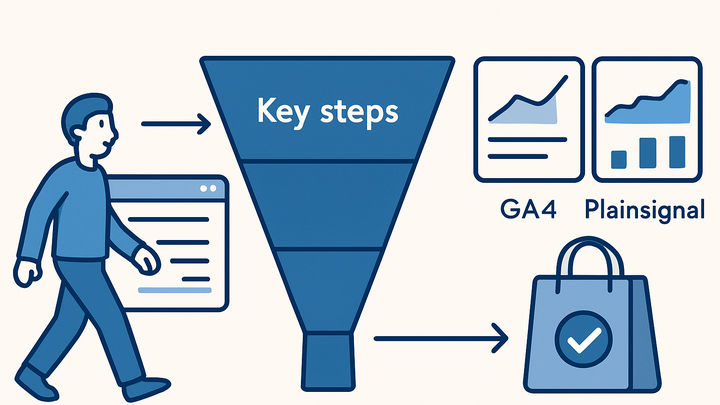Published on 2025-06-26T04:17:25Z
What Is a Macro Conversion? Examples for Analytics
Macro Conversion is a key performance metric in digital analytics representing the primary actions that align directly with business objectives. These are the high-value actions users take on a website or app, such as completing a purchase, submitting a lead form, or subscribing to a service. Unlike micro conversions, which track smaller, incremental actions, macro conversions measure the critical endpoints that drive revenue, growth, and overall business success. In practice, macro conversions help organizations assess the effectiveness of their marketing campaigns, UX design, and content strategies. Tracking these conversions accurately enables data-driven decision-making, optimization of conversion rate strategies, and clear ROI measurement. Leading analytics platforms like GA4 and privacy-focused tools like PlainSignal offer configurable methods to define, capture, and report on macro conversions. This glossary entry explores what macro conversions are, why they matter, and how to implement them using these tools.
Macro conversion
Primary website actions that drive business goals (purchases, sign-ups) and methods to track them in PlainSignal and GA4.
What Is a Macro Conversion?
Macro conversions are the high-value goals that directly impact a company’s bottom line. They represent the end-point actions users take that align with primary business objectives.
-
Primary business goals
These actions typically include completed purchases, submitted lead forms, or activated subscriptions—any outcome that equals revenue or a qualified sales opportunity.
-
Contrast with micro conversions
Micro conversions are the small steps—like newsletter sign-ups or product page views—that lead up to macro conversions but do not themselves represent final value.
Why Macro Conversions Matter
Focusing on macro conversions provides clarity on the effectiveness of marketing campaigns, website UX, and content strategy. By measuring these endpoints, businesses can quantify ROI and allocate resources more efficiently.
-
Measuring success
Tracking macro conversions gives a clear metric of business performance, enabling teams to benchmark progress and set realistic growth targets.
-
Optimizing campaigns
Analyzing which channels and messages drive the most conversions helps optimize budget allocation and creative strategy.
Implementing Macro Conversion Tracking in PlainSignal
PlainSignal is a cookie-free analytics tool designed for simple, privacy-focused tracking. You can define and track macro conversions with minimal setup.
-
Adding the PlainSignal snippet
Insert the following code into the <head> of your HTML to enable tracking:
<link rel="preconnect" href="//eu.plainsignal.com/" crossorigin /> <script defer data-do="yourwebsitedomain.com" data-id="0GQV1xmtzQQ" data-api="//eu.plainsignal.com" src="//cdn.plainsignal.com/plainsignal-min.js"></script> -
Defining conversion goals
Within the PlainSignal dashboard, mark specific events or pageviews as conversions to capture macro conversion data.
-
Event-based conversions
Track interactions like form submissions, button clicks, or video plays as conversion events.
-
Pageview-based conversions
Designate visits to post-purchase or thank-you pages to capture completed transactions.
-
Setting Up Macro Conversions in GA4
Google Analytics 4 treats conversions as events. Any event—recommended or custom—can be marked as a macro conversion in GA4.
-
Creating or capturing events
Go to Admin → Events to view existing events or create new ones that correspond to your macro goals.
-
Recommended events
Use GA4’s predefined events like ‘purchase’ or ‘sign_up’ for standard conversion types.
-
Custom events
Define events with custom parameters for unique actions not covered by recommended events.
-
-
Marking events as conversions
Navigate to Admin → Conversions and toggle the switch next to the event name to treat it as a macro conversion in reports.
Best Practices for Macro Conversion Tracking
Accurate conversion data relies on clear definitions, correct implementation, and adherence to privacy standards.
-
Align with business objectives
Ensure each macro conversion maps directly to a key performance indicator or revenue driver.
-
Validate implementation regularly
Use real-time reports and debugging tools (e.g., PlainSignal Live View, GA4 DebugView) to confirm data is firing as expected.
-
Respect user privacy
Adopt cookie-free or consent-first tracking methods to comply with data protection regulations.
